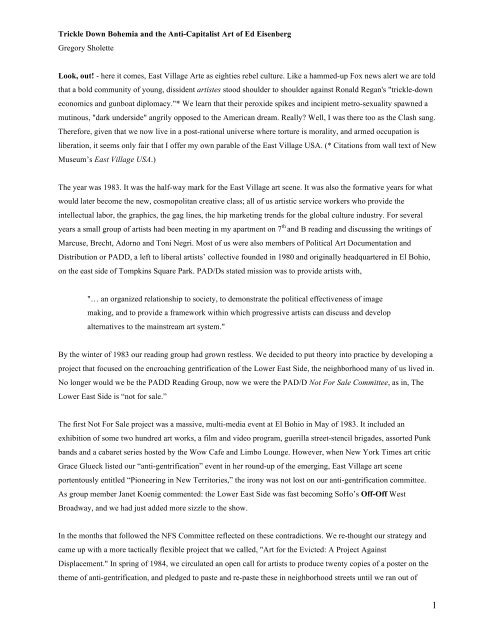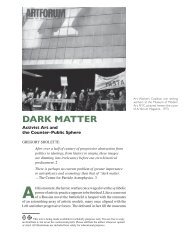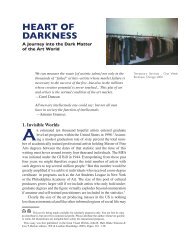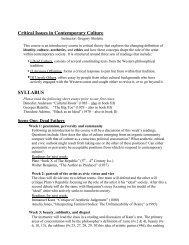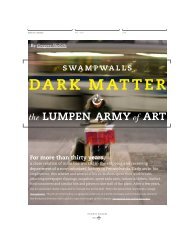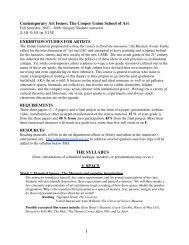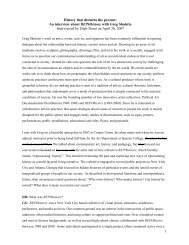Trickle Down Bohemia and the Anti-Capitalist Art ... - Gregory Sholette
Trickle Down Bohemia and the Anti-Capitalist Art ... - Gregory Sholette
Trickle Down Bohemia and the Anti-Capitalist Art ... - Gregory Sholette
You also want an ePaper? Increase the reach of your titles
YUMPU automatically turns print PDFs into web optimized ePapers that Google loves.
<strong>Trickle</strong> <strong>Down</strong> <strong>Bohemia</strong> <strong>and</strong> <strong>the</strong> <strong>Anti</strong>-<strong>Capitalist</strong> <strong>Art</strong> of Ed Eisenberg<br />
<strong>Gregory</strong> <strong>Sholette</strong><br />
Look, out! - here it comes, East Village <strong>Art</strong>e as eighties rebel culture. Like a hammed-up Fox news alert we are told<br />
that a bold community of young, dissident artistes stood shoulder to shoulder against Ronald Regan's "trickle-down<br />
economics <strong>and</strong> gunboat diplomacy."* We learn that <strong>the</strong>ir peroxide spikes <strong>and</strong> incipient metro-sexuality spawned a<br />
mutinous, "dark underside" angrily opposed to <strong>the</strong> American dream. Really? Well, I was <strong>the</strong>re too as <strong>the</strong> Clash sang.<br />
Therefore, given that we now live in a post-rational universe where torture is morality, <strong>and</strong> armed occupation is<br />
liberation, it seems only fair that I offer my own parable of <strong>the</strong> East Village USA. (* Citations from wall text of New<br />
Museum’s East Village USA.)<br />
The year was 1983. It was <strong>the</strong> half-way mark for <strong>the</strong> East Village art scene. It was also <strong>the</strong> formative years for what<br />
would later become <strong>the</strong> new, cosmopolitan creative class; all of us artistic service workers who provide <strong>the</strong><br />
intellectual labor, <strong>the</strong> graphics, <strong>the</strong> gag lines, <strong>the</strong> hip marketing trends for <strong>the</strong> global culture industry. For several<br />
years a small group of artists had been meeting in my apartment on 7 th <strong>and</strong> B reading <strong>and</strong> discussing <strong>the</strong> writings of<br />
Marcuse, Brecht, Adorno <strong>and</strong> Toni Negri. Most of us were also members of Political <strong>Art</strong> Documentation <strong>and</strong><br />
Distribution or PADD, a left to liberal artists’ collective founded in 1980 <strong>and</strong> originally headquartered in El Bohio,<br />
on <strong>the</strong> east side of Tompkins Square Park. PAD/Ds stated mission was to provide artists with,<br />
"… an organized relationship to society, to demonstrate <strong>the</strong> political effectiveness of image<br />
making, <strong>and</strong> to provide a framework within which progressive artists can discuss <strong>and</strong> develop<br />
alternatives to <strong>the</strong> mainstream art system."<br />
By <strong>the</strong> winter of 1983 our reading group had grown restless. We decided to put <strong>the</strong>ory into practice by developing a<br />
project that focused on <strong>the</strong> encroaching gentrification of <strong>the</strong> Lower East Side, <strong>the</strong> neighborhood many of us lived in.<br />
No longer would we be <strong>the</strong> PADD Reading Group, now we were <strong>the</strong> PAD/D Not For Sale Committee, as in, The<br />
Lower East Side is “not for sale.”<br />
The first Not For Sale project was a massive, multi-media event at El Bohio in May of 1983. It included an<br />
exhibition of some two hundred art works, a film <strong>and</strong> video program, guerilla street-stencil brigades, assorted Punk<br />
b<strong>and</strong>s <strong>and</strong> a cabaret series hosted by <strong>the</strong> Wow Cafe <strong>and</strong> Limbo Lounge. However, when New York Times art critic<br />
Grace Glueck listed our “anti-gentrification” event in her round-up of <strong>the</strong> emerging, East Village art scene<br />
portentously entitled “Pioneering in New Territories,” <strong>the</strong> irony was not lost on our anti-gentrification committee.<br />
As group member Janet Koenig commented: <strong>the</strong> Lower East Side was fast becoming SoHo’s Off-Off West<br />
Broadway, <strong>and</strong> we had just added more sizzle to <strong>the</strong> show.<br />
In <strong>the</strong> months that followed <strong>the</strong> NFS Committee reflected on <strong>the</strong>se contradictions. We re-thought our strategy <strong>and</strong><br />
came up with a more tactically flexible project that we called, "<strong>Art</strong> for <strong>the</strong> Evicted: A Project Against<br />
Displacement." In spring of 1984, we circulated an open call for artists to produce twenty copies of a poster on <strong>the</strong><br />
<strong>the</strong>me of anti-gentrification, <strong>and</strong> pledged to paste <strong>and</strong> re-paste <strong>the</strong>se in neighborhood streets until we ran out of<br />
1
copies. An exhibition poster was also produced at <strong>the</strong> Lower East Side Print Shop that sardonically announced four,<br />
new art galleries:<br />
1. The Discount Salon,<br />
2. Ano<strong>the</strong>r Gallery,<br />
3. The Leona Helmsley Gallery which was located on <strong>the</strong> <strong>the</strong>n derelict Christa Dora now filled with multimillion<br />
dollar condos, <strong>and</strong> most prophetically,<br />
4. The Guggenheim <strong>Down</strong>town<br />
All of <strong>the</strong>se were in fact boarded up buildings.<br />
In April <strong>the</strong> NFS exhibition opened at The Guggenheim <strong>Down</strong>town at <strong>the</strong> corner of Avenue ‘A’ <strong>and</strong> 10 th Street.<br />
Local housing activists joined PADD <strong>and</strong> set up card tables with housing literature <strong>and</strong> voter registration forms.<br />
Several months later, cultural critic Craig Owens championed <strong>the</strong> project in an essay for <strong>Art</strong> in America. Owens<br />
stated that PAD/D had mobilized, “resistance against, <strong>the</strong> political <strong>and</strong> economic interests which East Village art<br />
serves... " Notably, Owens generous <strong>and</strong> also sadly mistaken commentary was one of <strong>the</strong> few occasions in which<br />
PAD/D was discussed within an art world context. (Craig Owens, Commentary: The Problem with Puerilism in <strong>Art</strong><br />
in America, Summer 1984.)<br />
Now, <strong>the</strong> balance of my remarks will focus on one particular member of PAD/D’s Not For Sale Committee, Ed<br />
Eisenberg <strong>and</strong> his contribution to <strong>the</strong> 1984 Not For Sale street exhibition. My concern here is of course to present<br />
you with an alternative reading of <strong>the</strong> East Village phenomenon, but also to fulfill my promise of spinning a new<br />
East Village parable that I call: “<strong>Trickle</strong> <strong>Down</strong> <strong>Bohemia</strong> <strong>and</strong> <strong>the</strong> <strong>Anti</strong>-<strong>Capitalist</strong> <strong>Art</strong> of Ed Eisenberg.”<br />
Eisenberg was a founding member of PAD/D in 1980, he also produced <strong>the</strong> anti-nuclear, street stencil project<br />
Groundwork in 1988, <strong>and</strong> was a founding member of REPOhistory in 1989. Trained as a classical musician,<br />
Eisenberg was also a gay man who’s strident, anti-capitalist outlook often placed him at odds with <strong>the</strong> identityoriented<br />
politics of <strong>the</strong> 1980s, <strong>and</strong> continued to do so until his death in 1997 from complications brought on by<br />
AIDS.<br />
Eisenberg’s sexual politics linked him to <strong>the</strong> radical mission of <strong>the</strong> early Gay Rights movement when personal<br />
liberation was understood to be part of <strong>the</strong> larger struggle waged against authoritarianism, militarism <strong>and</strong> economic<br />
injustice. As historian Richard Mayer recently argued in a paper at <strong>the</strong> College <strong>Art</strong> Association: <strong>the</strong> 1970s notion of<br />
a broad-based, sexual revolution was supplanted in <strong>the</strong> 1980s by <strong>the</strong> packaging of homosexuality as a hip, urban<br />
lifestyle. At <strong>the</strong> same time, Eisenberg's point of view had a profound connection with <strong>the</strong> history of left wing<br />
political resistance that characterized New York’s Lower East Side.<br />
Eisenberg’s street poster, Regonomic Galleries explicitly lampooned <strong>the</strong> Laissez Faire “supply-side” economics<br />
of Ronald Reagan who was <strong>the</strong>n about to enter his second term as president. Reagan’s enormous tax cuts for <strong>the</strong><br />
wealthy <strong>and</strong> for corporations were often derided as “trickle down economics.” In <strong>the</strong>ory it worked like this: capital<br />
diverted from <strong>the</strong> public sector would now be invested in <strong>the</strong> private, business sector. This would allegedly generate<br />
new job opportunities up <strong>and</strong> down <strong>the</strong> economic ladder. Thus <strong>the</strong> trickle-down metaphor was born. In realty<br />
2
however, Reagan’s constriction of <strong>the</strong> money supply coupled with <strong>the</strong> de-regulation of markets <strong>and</strong> <strong>the</strong> de-funding<br />
of worker’s security benefits led to a widening of <strong>the</strong> income gap, longer work hours <strong>and</strong> accelerated production<br />
schedules.<br />
Curiously however, supply side economics appears to have fared better within <strong>the</strong> rarified market of <strong>the</strong> art industry<br />
than it did in <strong>the</strong> general economy. (Which may in fact have been its underlying objective: that is, to transform a<br />
blue collar, unionized work force into a malleable, service oriented work force better suited for <strong>the</strong> Post-Fordist,<br />
global economy.) Regardless, with surplus capital to burn why would anyone but <strong>the</strong> state want to invest in such<br />
loosing propositions as day care centers or legal aid? The logical place to park excess money is in long-term<br />
investments such as real estate <strong>and</strong> of course art. And <strong>the</strong>re is an added bonus that comes with buying art: prestige.<br />
Unquestionably <strong>the</strong> market for contemporary art soared in <strong>the</strong> 1980s. Suddenly <strong>the</strong>re were more dealers, more<br />
artists, more art programs training more art students. Not surprisingly, fledgling commercial galleries found<br />
financially depressed urban niches ––such as <strong>the</strong> East Village–– sensible places to set up business. But soon enough,<br />
<strong>the</strong>se start-up ventures were feeding new talent to established art world venues, much in <strong>the</strong> way <strong>the</strong> not-for-profit,<br />
alternative spaces did for commercial galleries in <strong>the</strong> 1970s. Looked at this way, <strong>the</strong> 1980s art star phenomenon<br />
was a logical outcome of <strong>the</strong> glutted market. Ra<strong>the</strong>r than spread <strong>the</strong> wealth, artistic overproduction eventually led to<br />
<strong>the</strong> implementation of mechanisms for differentiating <strong>and</strong> concentrating artistic value. (And one might say that <strong>the</strong><br />
exhibition East Village USA is merely a belated effort to achieve this same distillation.)<br />
Meanwhile, <strong>the</strong> local, non-art world economy of <strong>the</strong> East Village was forcibly being adjusted to meet changing<br />
demographics needs. Unprecedented numbers of low income <strong>and</strong> blue-collar residents were driven away from New<br />
York City thanks to a combination of lost manufacturing jobs, <strong>and</strong> rising rents. (There was a 25% loss in<br />
manufacturing in <strong>the</strong> 1980s, <strong>and</strong> <strong>the</strong> median rents doubled city-wide.) On <strong>the</strong> streets of <strong>the</strong> Lower East Side this<br />
3
meant that ethnic restaurants, used clothing stores, dive bars <strong>and</strong> funky book shops were exchanged for <strong>the</strong><br />
cornucopia of faux bistros <strong>and</strong> cafés, flower shops <strong>and</strong> French cleaners that make up what Saskia Sassen calls <strong>the</strong><br />
luxury zones of global cities.<br />
Ed Eisenberg’s poster sought to comment on this process by mapping Regonomics onto <strong>the</strong> New York art world of<br />
<strong>the</strong> 1980s. The trickle down metaphor is visualized in his artwork as a waterfall, color-photocopied onto an 8 1/2 by<br />
14 inch sheet of legal paper. Superimposed over <strong>the</strong> scene are six cascading text boxes. These are filled with terse<br />
descriptions of supply side economics that <strong>the</strong> artist adapted to fit <strong>the</strong> evolving stages of <strong>the</strong> East Village art scene:<br />
Step 1: Reagan’s unprecedented tax cut for corporations <strong>and</strong> upper income households in 1981.<br />
Step 2: The sharp increase of investment by corporations in cultural capital (Not Eisenberg’s term.)<br />
Step 3: The invention of a new art scene for managing this rising dem<strong>and</strong>, <strong>and</strong> finally,<br />
Step 4: A limited prosperity for some artists; <strong>and</strong> what Eisenberg terms “dehydration” for <strong>the</strong> urban poor.<br />
Visually, Reaganomic Galleries looked incongruous on <strong>the</strong> boarded up buildings of Loisida. This was not Christi<br />
Rupp’s scurrying rats or Becky Howl<strong>and</strong>’s insatiable real estate octopus. Instead, Eisenberg’s poster offered an<br />
absurd, pastoral image with unambiguous iconography resembling a medieval emblem or allegory. Eisenberg’s<br />
approach most likely borrowed from John Heartfield’s agitational photomontages of <strong>the</strong> 1930s, (Note, <strong>the</strong> PADD<br />
reading group discussed Heartfield at length.) I am thinking in particular here of Heartfiled’s use of natural history<br />
<strong>and</strong> zoology as political allegories. In such works as German Natural History <strong>the</strong> image of nature functions<br />
negatively drawing our attention to <strong>the</strong> way political <strong>and</strong> economic structures are transformed into seemingly natural<br />
events by bourgeois ideology. And certainly Reganomics with its explicit invocation of Adam Smith represents <strong>the</strong><br />
epitome of such naturalization: a retrogression that continued to pupate, if more slowly, under Bush Senior followed<br />
by Bill Clinton, only to emerge full-blown under <strong>the</strong> present administration.<br />
Therefore, in conclusion, by situating Ed Eisenberg <strong>and</strong> his work within <strong>the</strong> East Village of <strong>the</strong> 1980s one cannot<br />
avoid dragging along overlapping concerns involving real estate, politics, activism <strong>and</strong> so forth. Looked at this way,<br />
<strong>the</strong> East Village USA was really more like a train wreck involving multiple histories <strong>and</strong> tendencies all accelerated<br />
by a rapidly evolving economic engine. At <strong>the</strong> same time, <strong>the</strong> lasting cultural influence of East Village USA may<br />
have nothing to do with art, at least in <strong>the</strong> sense that we are using that term here, <strong>and</strong> have much more to do with <strong>the</strong><br />
ascendancy of <strong>the</strong> new, immaterial labor force <strong>and</strong> its craving for a trickle down, watered down version of urban<br />
bohemia. <strong>Gregory</strong> <strong>Sholette</strong>, 3/18/05<br />
For more on PAD/D see:<br />
"A Collectography of PAD/D, Political <strong>Art</strong> Documentation <strong>and</strong> Distribution: a 1980's Activist <strong>Art</strong> <strong>and</strong> Networking<br />
Collective,” http://info.interactivist.net/article.pl?sid=03/04/01/1532234&mode=nested&tid=22<br />
For more on <strong>the</strong> relationship of art, gentrification <strong>and</strong> <strong>the</strong> new cosmopolitanism see:<br />
“Mysteries of <strong>the</strong> Creative Class, or, I Have Seen The Enemy <strong>and</strong> They Is Us,”<br />
http://www.metamute.com/look/article.tpl?IdLanguage=1&IdPublication=1&NrIssue=29&NrSection=10&Nr<strong>Art</strong>icle=1476<br />
4


